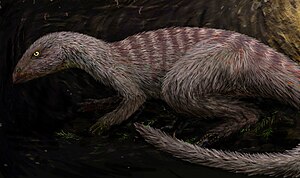Oryctodromeus
| Oryctodromeus | ||||||||||||
|---|---|---|---|---|---|---|---|---|---|---|---|---|

Graphic representation of Oryctodromeus |
||||||||||||
| Temporal occurrence | ||||||||||||
| Upper Cretaceous ( Cenomanium ) | ||||||||||||
| 100.5 to 93.9 million years | ||||||||||||
| Systematics | ||||||||||||
|
||||||||||||
| Scientific name | ||||||||||||
| Oryctodromeus | ||||||||||||
| Varricchio , Martin & Katsura , 2007 |
Oryctodromeus ("burrowing runner") is a genus of small ornithopod dinosaurs , of which only the type Oryctodromeus cubicularis ( Latin cubiculum - bedroom ) has been scientifically described . The Latin species name indicates that the fossils of the species, an incompletely preserved adult specimen and two incomplete juveniles, were apparently found in a self-dug earthworks.
The finds come from the early Upper Cretaceous ( Cenomanium ) of the US state of Montana .
description
Oryctodromeus cubicularis was a medium-sized, two-legged dinosaur about two meters long, of which the tail accounted for a little over half. The weight was estimated at 22 to 32 kg. The forelegs were more developed than related species and the pelvic and hind bones were well developed. The broad head had a shovel-like muzzle. From the sum of these features, the discoverers concluded that the species was well adapted to digging in the ground.
Way of life
The remains of the species were found in an earthworks that had a sloping, winding tunnel and an enlarged chamber at the end about two meters deep. The duct was about 30 cm in diameter, which is just over the width of the adult animal. The explorers assume that the animal dug the den as a hiding place for its young. The relative size of the young indicates a longer period of brood care. The earthworks could also have served as protection against unfavorable environmental influences.
The species was likely herbivorous and able to walk quickly due to the long hind legs on the surface of the earth.
Systematics
Oryctodromeus belongs to the basal euornithopods and is probably closely related to the genera Orodromeus and Zephyrosaurus . Because of the physique similarities between these animals, it is believed that all of these species were capable of digging earthworks and foraging. The classification into a family was not made.
literature
- David J. Varricchio, Anthony J. Martin, Yoshihiro Katsura: First Trace and Body Fossil Evidence of a Burrowing, Denning Dinosaur. In: Proceedings of the Royal Society. Series B: Biological Sciences. Vol. 274, No. 1616, ISSN 0950-1193 , pp. 1361–1368, doi : 10.1098 / rspb.2006.0443 , PMC 2176205 (free full text, PDF).
Web links
- Article in Der Spiegel with illustration
Individual evidence
- ^ Gregory S. Paul : The Princeton Field Guide To Dinosaurs. Princeton University Press, Princeton NJ et al. 2010, ISBN 978-0-691-13720-9 , p. 276, online .